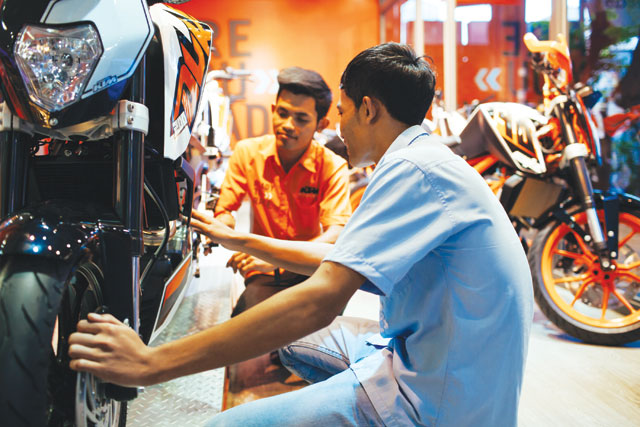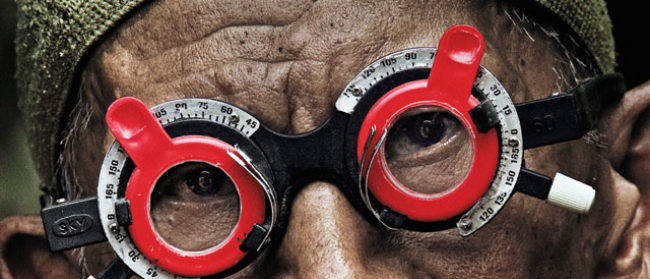When Bun Chhay was given his first motorcycle a year ago – a gift from his parents for graduating from university – he envisaged himself cruising alongside his friends on a Honda Supersport or a Kawasaki Ninja. Instead, he came away with a brand new 110cc Honda Dream.
“I was disappointed,” admitted Bun, as he straddled an Aprilia ETZ 150 at the manufacturer’s promo concession in Phnom Penh’s Aeon Mall. “My friends all have really fast and powerful bikes. They make fun of me because mine is slow.”
As Bun swivelled the accelerator and rocked the stationary motorcycle left and right, his father explained that Honda Dreams are the safest and most reliable motorcycles that can be bought in Cambodia. “Everybody has one. And there’s a reason everybody has one. My son is not very sensible, so I don’t want him riding a powerful motorbike like that,” he said, pointing to Bun who was now posing for a photograph with a model on the back of an Aprilia RSV4 1,000cc.
The streets of Cambodia have long been characterised by the high-pitched revs of small-engine motorcycles and the frail growl of decrepit scooters on the verge of decay. “Traditionally, the three selling points for a motorbike were its low price, ability to carry more than two people and resilience,” explained Bun’s father. “We bought motorbikes that would last for ten or 20 years – they were an egalitarian mode of transport.”
According to the Ministry of Public Works and Transport, there were 2.06 million registered motorcycles in 2013, about one for every seven people. However, the actual number could be much higher as not all vehicles are registered. The majority of these bikes certainly adhere to practicality and affordability as the key purchasing criteria.
However, over the past few years there has been a noticeable shift in the motorcycle landscape. A growing number of Cambodians are turning their backs on durability, plumping instead for speed, size and power. It is now not uncommon to see a Ducati outpacing a Honda Cub on the streets of Phnom Penh or a posse of KTMs roaring down a recently resurfaced national road.
“In June, we opened our showroom in Phnom Penh and we’ve seen good success, selling more than 50 bikes [in the first four months],” said Gary Ng, general manager of Ming Wuoy Group, the authorised dealer in Cambodia of the Italian manufacturer Aprilia. Motorcycles sold by Aprilia range in price from $1,000 up to $12,000. “We are confident for the future as we see the market changing due to the growing middle class. People can afford more expensive motorbikes and they want faster, more powerful and better-looking ones.”
While the world’s largest motorcycle manufacturers, Honda and Yamaha, have been active in Cambodia for decades and continue to dominate the market, the past two years have seen a swathe of new showrooms and dealerships selling high-end motorcycles. In 2012, Europe’s largest manufacturer of motorbikes, Piaggio, opened a distributor and showroom in Phnom Penh.
A Ducati showroom is expected to open in early 2015, and a Harley-Davidson dealership has got the green light to open next year. Austrian company KTM is currently building a second showroom in Phnom Penh and, according to its after-sales manager, Hlaing Moe David, has sold about 3,000 motorcycles in two years.
“It’s about the freedom and thrill you get from riding a powerful motorbike. It’s far more addictive than cigarettes or alcohol,” said Kor Woh Hock, the former president of the Cambodia Bikers Club, a multicultural group of enthusiasts that gathers regularly to ride around the Kingdom. “You can see that there has been a cultural change for motorbikes. More and more Cambodians want to be seen on luxury bikes – it’s more important than just getting from A to B.”
According to the Malaysian, who has lived in Cambodia for the past 17 years, the shift is a result of two factors: the growth of a young, urban middle class with disposable incomes, and the development of credit financing.
Years of economic growth have led to a recognisable and sizeable middle class emerging in Cambodia, defined by the World Bank as those with a daily consumption expenditure of between $2.60 and $5.10, accounting for almost 20% of the 14 million population. Traditionally, the sight of luxury car brands such as Rolls-Royce and Bentley would have been a key indicator of prosperity, but for the younger generation, high-end motorcycles are the new markers of conspicuous consumption.

“Motorbikes are a status symbol for a lot of Cambodians. It’s showing their wealth and their social position,” said Hock. “It’s different from owning a luxury car. Nowadays, you see luxury cars everywhere. But you don’t see a Harley-Davidson or a Ducati every day. So owning one is something unique and individual.”
The ability of middle-class Cambodians to afford high-end motorcycles has also been boosted by the rise of the credit industry. According to a report by the Credit Bureau of Cambodia, over the past two years outstanding loans have risen from $2.5 billion to $5.7 billion, and those figures are expected to rise to $14 billion by 2020.
In 2012, GL Finance became the Kingdom’s first financial leasing company when it opened a branch in Phnom Penh. A subsidiary of the Thai-based Group Lease, GL Finance formed an exclusive partnership with Honda NCX – the Cambodian Honda franchise – offering leasing and hire purchase. According to the company’s 2013 annual report, last year it was financing an average of 100 motorcycles each month.
Back at the Aprilia promo in Aeon Mall, Bun Chhay said that he intended to buy one of the motorcycles on show because of the attractive instalment plan offered. “I couldn’t buy the bike outright, it’s too expensive,” he said. “But they offer [a finance package] of $88 per month over 34 months, which I can afford.”
Despite the rise of high-end bikes, market leaders Honda and Yamaha have few concerns about their positions. “In Cambodia there are almost 200,000 [brand new] motorbikes sold each year,” said Tola Seang, general manager of Yamaha Motor Cambodia’s commercial department. “Although the introduction of newer brands might damage our profits slightly, especially on our sports bikes, Yamaha is a brand that people recognise and I don’t think we will be greatly affected.”
He added that the basic models of Yamaha and Honda will still be the biggest sellers in the future and that the majority of the population can only afford secondhand motorcycles.
[Owning an expensive motorcycle] says to society: ‘I matter, I have arrived, I am successful.’
Simon Springer
Vanna Sok is one such Cambodian. He has dreamed of owning a Kawasaki ever since he saw the classic green Ninja on television several years ago. “A friend from school, he now owns a Ducati. I see his photographs on Facebook,” he said with disappointment. “But [those motorcycles] are too expensive for me.” When Vanna is not taxiing around passengers on his father’s trusty Daelim for a few dollars a day, he works at his uncle’s motorcycle repair shop near Toul Tompoung in the south of Phnom Penh.
“I see lots of new, powerful bikes come to the shop,” Vanna continued. “One customer told me he was selling a Kawasaki for $1,000. I don’t have the money, but I would really like to own one.”
According to Simon Springer, an academic at the University of Victoria and author of several books on the Cambodian economy, the rise of consumerism as a “necessary by-product” of the country’s transition to capitalism has not only impacted on the middle and upper classes, but also on the poorer sections of society.
“There is a false promise sold to the poor that their upward mobility is linked to things such as buying the right brands… The wider impact, though, is that it reinforces ideas of class, as people are acutely aware of their access or lack of access to such material items,” said Springer.
The World Bank has classified 77% of Cambodia’s population as “poor” or “vulnerable poor” and, for the majority, owning a sleek motorcycle is an unattainable dream. In the short-term, that remains the preserve of the privileged few. The few like Bun Chhay, who outlined his automotive ambitions in front of his tutting father.
“For now, I really want an Aprilia,” he said. “But in the future, when I get more promotions, maybe I’ll buy a Harley-Davidson too.”


